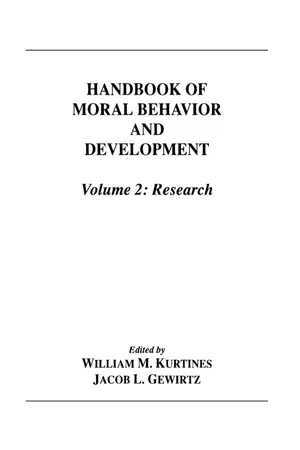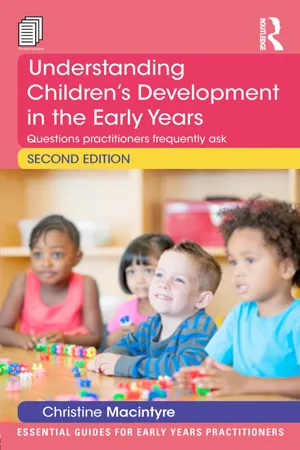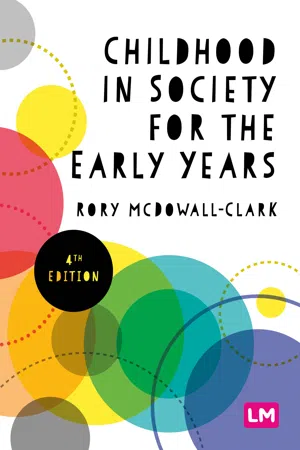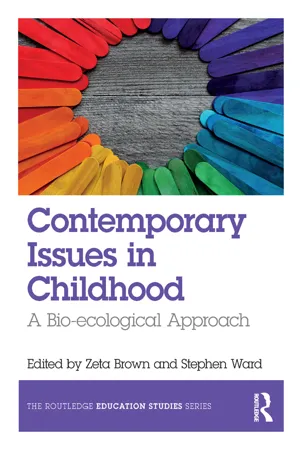Psychology
Social Development in Early Childhood
Social development in early childhood refers to the gradual acquisition of social skills and understanding of social norms and relationships during the first few years of life. This includes the development of empathy, cooperation, and communication abilities. It is a critical period for laying the foundation for future social interactions and relationships.
Written by Perlego with AI-assistance
Related key terms
7 Key excerpts on "Social Development in Early Childhood"
- eBook - ePub
Handbook of Moral Behavior and Development
Volume 2: Research
- William M. Kurtines, Jacob Gewirtz, Jacob L. Lamb(Authors)
- 2014(Publication Date)
- Psychology Press(Publisher)
5 Social and Moral Development in Early Childhood Melanie Killen ABSTRACTThe focus of this chapter is on social-cognitive development in early childhood and on some of the studies which have examined social judgment and moral behavior in the preschool period. It is asserted that in order to understand early social development it is necessary to be explicit about the criteria used for determining social and moral categories of behavior. In addition, a sensitivity to the context needs to be incorporated into both research methodologies and theoretical interpretations of early behavior and development. It is argued that research which has taken these issues into account has provided a more differentiated model of early social and moral development than has been previously postulated.INTRODUCTIONThe focus of this chapter is on social-cognitive development in early childhood and on the existing evidence for social judgment and moral behavior in the preschool period. This chapter makes two central points: (1) that in order to understand early social and moral development it is necessary to be explicit about the criteria for analyzing “social” and “moral” categories of behavior, and (2) that it is essential to conduct detailed analyses of the social context. It is argued that the movement towards the use of explicit criteria and a sensitivity to the context has led to a characterization of early development as differentiated, rather than global, and as reflecting a moral, rather than premoral orientation. This new characterization differs from the traditional one espoused by the predominant theoretical models in the field which initiated much of the work on social and moral development.In this chapter, the theoretical foundations of research on early social and moral development are described followed by an examination of selected research in social and moral development. In addition, current research on preschoolers’ social interactions and social judgments is discussed. The aim of this research has been to analyze how children resolve conflicts in the preschool setting. This has been done by investigating the role of context variables on social exchanges and by determining the social and moral components of conflict episodes. - eBook - ePub
Early Childhood Studies
Principles and Practice
- Jane Johnston, Lindy Nahmad-Williams, Ruby Oates, Val Wood(Authors)
- 2018(Publication Date)
- Routledge(Publisher)
et al ., 2006: 363) states that the term socialisation describes the ‘process whereby people learn to conform to social norms’. The process of social development can be considered as the internalisation of social norms or social rules, which become internal to the individual. These social rules may be an essential element of social interaction.Early social development, through the process of socialisation, can be observed by attending to the behaviour of, and interactions between, infants and their carers and also within the environment. Babies can attract attention by moving, by making noises or by crying, in an effort to make their needs known because they are hungry or lonely and desire company. They can be seen listening and responding to sounds and movement in the environment, through different gurgling or babbling noises and facial expressions, in different ways depending on whether they are responding, playing or interacting with family members, with strangers or with peers.Infants and young children spend much of their time playing, and play is a significant factor in social development (see Picture 7.1 ). Through play we can both observe and be observed practising the actions and situations most relevant and common in our society. Play is recognised (e.g. Lindon and Brodie, 2016; Moyles, 2010) as an important part of all aspects of learning and of development (Johnston, 2005) in a creative and cross-curricular way.The emergence of language plays a large part in early social development through copying others and recognising sounds, and in developing independence through making our needs and intentions known to others (see Chapter 5 - eBook - ePub
Understanding Children's Development in the Early Years
Questions practitioners frequently ask
- Christine Macintyre(Author)
- 2014(Publication Date)
- Routledge(Publisher)
Chapter 6Understanding social developmentA group of early years practitioners was asked to name ‘the most important things they wished their children could do’ and after a lengthy discussion they compiled the list shown in Table 6.1 . They agreed that social development was critically important and their questions and answers are shared below.Q. Why should social development take priority?Well, social skills are the stepping stones if you like – if you can trust children not to hit each other and share the resources without squabbling and breaking them, then you have time to concentrate on teaching them something, but if you have to stop fights and bickering all the time, then nothing gets done. (Simon)■ TABLE 6.1 Some social skillsRespecting each other and the toys and other resources they have to play with (Simon) Being kind to one another (Sally) Learning to take turns (Amy) Caring and sharing (Megan) Learning to watch out for one another – to be aware of safety issues, especially when playing outside (Carol) Learning to be independent by deciding what they want to do, gathering all the things they need and getting on with it (Jo) Learning to cope when they get bumped or when pieces of work disappoint them (Dave) Listening to each other and following another's lead (Amy) Coping with the routine of the day – knowing what comes next (Omar) Having a friend and being able to share that friend with others (Fran) (The practitioners' names, in brackets, are given to ease referring back to the list). Q. How do you establish this kind of working atmosphere?We try to act as role models, keeping calm and praising those who are behaving well. We hope the others will copy them. If they don’t, then explaining why you are upset or disappointed is always better than being cross. (Sally) - eBook - ePub
An Educator's Guide to Infant and Toddler Development
Understanding and Responding Appropriately
- Jennifer Kaywork(Author)
- 2019(Publication Date)
- Routledge(Publisher)
Parents and caregivers who interact with infants and toddlers have the very important job of modeling and facilitating appropriate skills so that the children adopt them. These important adults are teaching the children from birth how to act and behave appropriately and have healthy social relationships. This process takes time and requires care and attention from adults.Appropriate socialization begins with secure attachments and opportunities to be social with others from early in life. Socialization with peers is present in the infant and toddler years when it is fostered by a secure child-caregiver bond. When infants interact with sensitive and responsive adults, they learn how to send and interpret emotional signals that they will then use in their first social interactions. Infants who have a warm relationship with their primary caregiver(s) will engage in more extended social exchanges with peers. Toddlers who are in childcare and have a secure attachment to a caregiver will show advanced social and play behavior with their peers. When these children reach the preschool years, they tend to show more socially competent behavior.Figure 9.1 Toddler Painting on an EaselErikson's Psychosocial Theory
Let’s begin with a discussion of a developmental theory that emphasizes the attachment/socialization bond. Erik Erikson’s Psychosocial Theory is a theory that shows the connection of attachment and social development. Erikson believed that the foundation of social and emotional development is formed in the early years of life. His theory is a stage theory where a person must overcome a “crisis” or “struggle” before continuing to the next stage. The resolution of the crisis/struggle then influences the way the crisis in the next stage will unfold.Erikson’s theory contributes to an early childhood educator’s knowledge of a person’s development as cumulative, with each developmental step laying the foundation for the next one. Each step forward is influenced by those that came before it. While Erikson’s believed that each stage occurred during a specific age or age range, I urge you to focus on the progression and order - eBook - ePub
- Rory McDowall Clark(Author)
- 2020(Publication Date)
- Learning Matters(Publisher)
1 The context of childhood: social understanding of childhoodThrough reading this chapter, you will:- consider the difficulty of defining ‘childhood’ and how we determine who is considered to be a ‘child’;
- examine the conflict and ambiguities that are raised by these questions;
- understand why the social context is so critical to an understanding of childhood.
Introduction
Until the final decades of the twentieth century the idea of childhood as a distinct and separate social category had been paid very little attention. Ideas about children have abounded throughout history (and will be explored further in Chapter 2 ) but children themselves were rarely considered important enough to warrant deliberate study. By the eighteenth century scientists, philosophers and educators had begun to systematically study children and build up knowledge about them. Since then, ideas about how children grow, the developmental stages they go through and different theories of how language is acquired have emerged as subjects of study within such fields as psychology, education and health. Thus, there is now a well-established body of knowledge known as child development which is studied by all those interested in working with children. Until the last few decades, the existence of a stage in human lifespan, called ‘childhood’, was simply taken for granted, however, and the concept itself was rarely examined or questioned. Today, a distinct interdisciplinary field called ‘childhood studies’ exists, uniting different approaches from diverse academic disciplines to bring the spotlight to bear, not only on children themselves but also on childhood as a unique social category.What is childhood?
Every adult was once a child; it is the one defining characteristic that each of us has in common regardless of the myriad differences that make us unique individuals. This ought to make it a fairly simple matter to understand exactly what childhood is and what the term signifies. However, the more we try to pin down and identify what we mean by childhood, the more slippery a concept it turns out to be. The difficulties this presents help to illustrate why childhood is a cultural and social invention and why it is so important to understand the context of childhood. - eBook - ePub
Contemporary Issues in Childhood
A Bio-ecological Approach
- Zeta Brown, Stephen Ward(Authors)
- 2017(Publication Date)
- Routledge(Publisher)
The chapter is in three sections: societal perspectives on CYP and their influence on education; CYP and their environment; and CYP and the involvement of practitioners/teachers, parents and carers. Each section includes four dimensions: cognitive, social, emotional and health. We discuss relevant societal outlooks and value systems that have influenced the current perceptions of policy-makers, professionals, carers and parents as well as the influence of societal factors and real-life contexts, inclusive of race, class and gender. These factors are compared and contrasted in relation to differing ways CYP live and learn, considering local, national and at times global contexts. Interpersonal relationships are explored in relation to CYPs' development and will include their relationships with immediate and extended family and settings including childcare, schools and activities in the local community.Societal perspectives on CYP and their influence on education
Cognitive development
Various disciplines carry out research in the area of cognitive development from different perspectives, including neuroscience, developmental psychology and behavioural genetic research. Neaum (2013:54) states ‘cognitive development is concerned with the construction of thought processes. It is concerned with how we acquire, organise and use what we learn. It involves the development of conceptual and conscious thought, memory, problem-solving, imagination and creativity.’ Information from these disciplines then influences policy, especially in education. For example, the white paper Educational Excellence Everywhere (DfE, 2016:89) states:Cognitive science has shed light on long-running debates about whether a school curriculum should focus more on ‘knowledge’ or ‘skills’. It shows that knowledge and skills are partners, and that attempts to teach skills without knowledge fail because they run counter to the way our brains work.Cognitive skills, including perception, memory and concept-formation, underpin the ability to learn, reason and problem-solve (Dowling, 2013). However, they are not in isolation from other areas such as health, emotional and social development. Teaching and supporting these areas of development in isolation would not support CYPs' overall development. As Dowling (2013:7) suggests: ‘we can of course teach an isolated skill such as categorising, but it's not much use if a child is not inclined to categorize things or people…' - Kathleen McCartney, Deborah Phillips(Authors)
- 2011(Publication Date)
- Wiley-Blackwell(Publisher)
These social influences are important because emotion understanding is a foundation for social competence in early childhood. Individual differences in preschoolers’ emotional competence – defined as capability in emotional expressiveness, emotion regulation, and emotion knowledge – predict teacher and peer measures of social competence both concurrently and in kindergarten (Denham, Blair, DeMulder, Levitas, Sawyer, AuerbachMajor, & Queenan, 2003). The emergence of individual differences in “emotional competence” (Saarni, 1999) or “affective social competence” (Halberstadt, Denham, & Dunsmore, 2001) in the preschool years is important in shaping children’s social skills and dispositions in ways that have implications not only for friendship and peer status but also for academic competence, self-image, and emotional well-being (Thompson & Raikes, in press).Early Emotional VulnerabilityThe importance of the family environment as a laboratory of early emotional development is underscored by the realization that even young children can experience the severity of trauma, depths of sadness and grief, and capacities for uncontrollable anger and aggression that traditionally were viewed as possible only at older ages (Shonkoff & Phillips, 2000). Young children who are witnesses to domestic violence, for example, are more likely to exhibit internalizing symptoms (such as depression and anxiety) and externalizing symptoms (such as aggression) as well as showing signs of post-traumatic stress disorder (Rossman, Bingham, & Emde, 1997; Rossman, Hughes, & Rosenberg, 2000). Comparable symptomatology can be observed in young children who have been maltreated (Cicchetti & Toth, 2000; Macfie, Cicchetti, & Toth, 2001). Young children also exhibit symptomatology of depression (Robinson & Garber, 1995), anxiety disorders (Vasey & Dadds, 2001), conduct and behavioral disorders (Owens & Shaw, 2003; Shaw, Gilliom, Ingoldsby, & Nagin, 2003), and other serious forms of affective psychopathology. The risk of serious psychological problems increases when children are in threatening or traumatizing circumstances like those described above, but psychological symptomatology certainly is not inevitable, and many children in these situations do not develop serious problems, especially when they have available to them social support and other resources for effective coping.
Learn about this page
Index pages curate the most relevant extracts from our library of academic textbooks. They’ve been created using an in-house natural language model (NLM), each adding context and meaning to key research topics.






